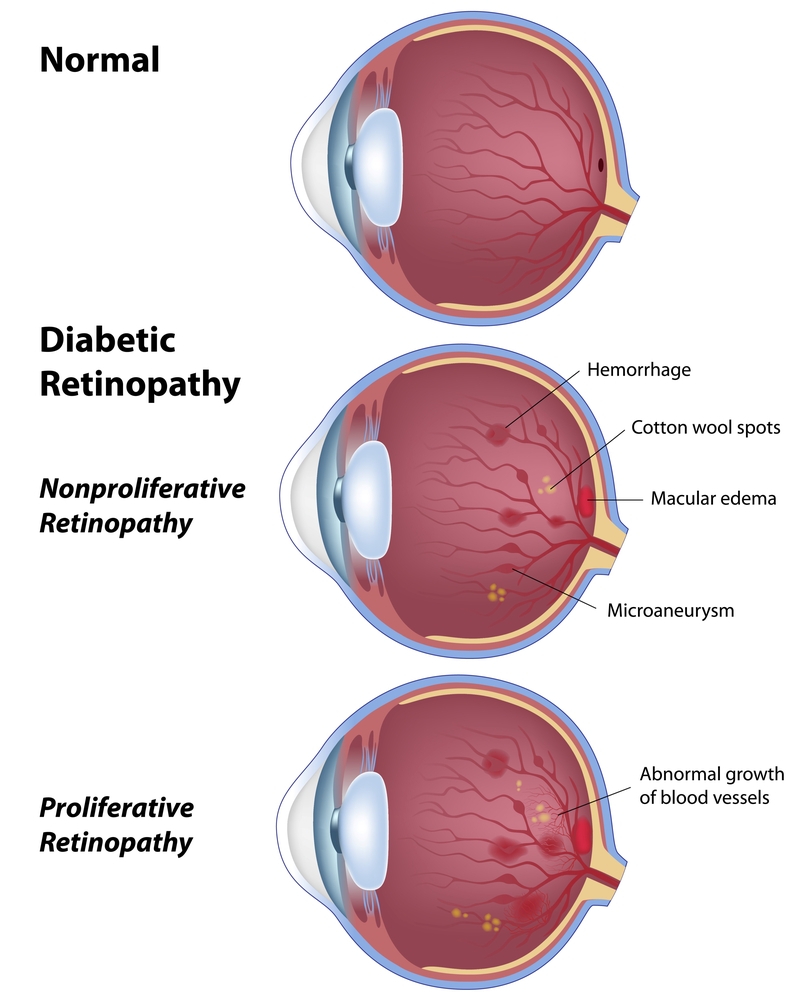Are You at Risk for Diabetic Retinopathy?
May 21, 2024
Diabetic retinopathy is a condition that affects the retina, the thin membrane that lines the back of the eye. It contains special cells called photoreceptors.
Photoreceptors translate the light that passes through your eye into impulses sent to your brain, which are processed as images. This makes the retina a vital part of your eye, as you wouldn't be able to see without it.
Diabetic retinopathy damages the retina, which can, in turn, cause irreversible vision loss. However, you can manage diabetic retinopathy to prevent vision loss.
Since the eye condition doesn't present early symptoms, the best way to treat it effectively is to diagnose it before irreversible damage is done to the retina. The only way to do this is to be aware of your risk for the eye condition and have eye exams accordingly.
Keep reading to find out if you could be at risk for diabetic retinopathy and what that could mean for your sight!
What is Diabetic Retinopathy?
 Diabetic retinopathy is an eye condition caused by diabetes. Diabetes occurs when the body has trouble making insulin needed to control blood sugar.
Diabetic retinopathy is an eye condition caused by diabetes. Diabetes occurs when the body has trouble making insulin needed to control blood sugar.
High blood sugar levels can negatively affect the body, including your vision. Diabetes puts you at higher risk for several eye conditions, but it can lead directly to diabetic retinopathy.
High blood sugar levels affect blood vessels, causing them to swell. Tiny blood vessels that supply your retina with oxygen are more susceptible to this effect.
When the blood vessels on the retina swell, they can burst and leak, causing damage to the retina as scar tissue forms. This can lead to permanent vision loss as photoreceptors are destroyed and unable to regenerate.
What are the Symptoms of Diabetic Retinopathy?
In the early stages of diabetic retinopathy, there are no noticeable symptoms. You won't be able to feel swelling or leaking blood vessels in the eye.
Sometimes, you can see spots in your eye as blood from burst blood vessels leaks into the vitreous, the gel-like substance that fills your eye.
If you suddenly start seeing spots, see your eye doctor right away. The sudden appearance of spots may indicate diabetic retinopathy or other serious eye conditions.
However, in addition to seeing spots, the first symptom of diabetic retinopathy is vision loss. Your vision will become blurry, and parts of it may go dark.
Eventually, you can go completely blind if the vision condition is left untreated. Vision loss from diabetic retinopathy is also irreversible, making eye exams crucial to diagnose and spot the eye condition as early as possible.
What are the Risk Factors of Diabetic Retinopathy?
If you have any form of diabetes, including type one, type two, and gestational diabetes, you're at risk for diabetic retinopathy. However, other factors can increase your risk of developing the eye condition, including:
- Uncontrolled blood sugar levels
- High cholesterol and blood pressure
- Pregnancy (either with pre-existing diabetes or gestational diabetes)
- Being of African, Hispanic, or Native American descent
- Having diabetes for a long time
Talk to your eye doctor about your medical history to determine if you're at high risk for diabetic retinopathy. Whether you're at an increased risk for the eye condition or considered at risk because you have diabetes, you should have regularly scheduled eye exams with your ophthalmologist at OMNI Eye Specialists.
The Importance of Eye Exams
If you have diabetes, you should have an eye exam at least once a year. If you're at an increased risk, you may need eye exams more often.
Your eye doctor will be able to tell you exactly how often you need eye exams and will give you the best schedule to follow based on these recommendations. Again, vision loss from diabetic retinopathy is irreversible.
The best way to save your vision is to have the eye condition diagnosed and treated as early as possible. Although you cannot cure diabetic retinopathy, you can manage it.
Managing the eye condition can slow it down, which may help prevent further damage to the retina and preserve your vision for years to come.
Learn More About Diabetic Retinopathy
Prevention and Treatment of Diabetic Retinopathy
 There is no way to prevent diabetic retinopathy, but you can lower your risk if you have diabetes. The best way to do so is by staying healthy and keeping your blood sugar levels managed.
There is no way to prevent diabetic retinopathy, but you can lower your risk if you have diabetes. The best way to do so is by staying healthy and keeping your blood sugar levels managed.
Even if you manage your diabetes well, remember that having the condition for an extended time increases your risk of developing diabetic retinopathy. That's why you should always be vigilant about keeping your eyes healthy and regularly schedule eye exams with your eye doctor at OMNI Eye Specialists.
Your eye doctor can spot the early signs of damage to the retina by examining it through your dilated pupil or using special imaging equipment. Examining the retina allows your eye doctor to see if your blood vessels are swollen, leaking, or growing abnormally before you ever experience any vision loss.
Once you are diagnosed with diabetic retinopathy, your ophthalmologist can customize your treatment plan. Several treatments are available, including injections that inhibit blood vessel growth and laser therapies that seal off or destroy leaking blood vessels.
Depending on the severity of your condition, you may need a combination of treatments. Treatment can significantly slow down damage to the retina and preserve your vision for years.
However, any treatment for diabetic retinopathy is most effective the earlier you receive a diagnosis, making eye exams with your ophthalmologist a must if you have diabetes. Do you think you could have diabetic retinopathy?
Learn more about this eye condition and how to treat it by requesting an appointment at OMNI Eye Specialists in Baltimore, Rosedale, Glen Burnie, Catonsville, and Parkville, MD!



